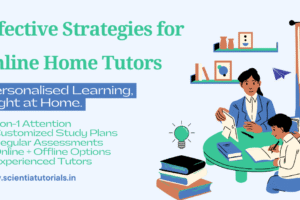Creating a Roadmap for Success: How Home Tutors Can Design a Structured Learning Plan
Introduction
Home tutoring has grown into an essential educational service, offering personalized attention and tailored lessons to help students achieve their academic goals. One of the most critical factors in ensuring the effectiveness of home tutoring is developing a well-organized and structured learning plan. Without clear direction, it can be easy for both the tutor and student to lose focus, leading to wasted time and suboptimal results. A structured learning plan not only keeps the sessions organized but also provides measurable goals and a pathway for academic success. This article will guide home tutors on how to create an effective learning plan, ensuring a productive and rewarding experience for both tutor and student.
1. Understanding the Student’s Needs and Objectives
Before diving into the creation of a learning plan, it is essential to assess the student’s individual needs, strengths, weaknesses, and academic objectives. This initial assessment will serve as the foundation for the entire plan and guide the direction of your tutoring sessions.
Key Tips:
- Conduct a detailed assessment through diagnostic tests, conversations with the student, and, if applicable, their parents.
- Identify specific subject areas where the student struggles and areas where they excel.
- Determine the short-term and long-term goals, such as improving grades, mastering a particular subject, or preparing for an exam.
A clear understanding of the student’s objectives will help in designing lessons that are not only relevant but also cater to the student’s unique learning style.
2. Setting Measurable Goals and Milestones
Once you have assessed the student’s needs, the next step is to establish measurable goals. These goals should be clear, specific, and achievable. The idea is to create a road map that breaks down large academic goals into smaller, manageable milestones that can be tracked over time.
Key Tips:
- Break down long-term goals into weekly, monthly, and term-based targets.
- Use SMART goals (Specific, Measurable, Achievable, Relevant, Time-bound) to ensure each objective is realistic.
- Discuss these goals with the student and, if relevant, their parents to make sure everyone is aligned.
For example, if the student struggles with math, a long-term goal could be to improve their math grade by the end of the school year. The short-term goal might be to master specific topics such as fractions or algebra in the next few weeks.
3. Creating a Customized Weekly Lesson Plan
The heart of a structured learning plan is the weekly lesson plan. This plan should outline what will be covered in each session, the resources needed, and how much time will be allocated to each task. Having a weekly lesson plan allows both the tutor and student to know what to expect, creating a more organized learning environment.
Key Tips:
- Design each lesson with a clear focus: for example, one session might focus on theory while another is dedicated to practice and problem-solving.
- Incorporate various learning activities to maintain student engagement, such as quizzes, interactive discussions, hands-on exercises, and review sessions.
- Set aside time for periodic assessments and review of previously learned material to ensure retention.
A structured weekly plan should also be flexible. While you should have a clear idea of what needs to be covered, adjustments may be necessary depending on how well the student is grasping the content.
4. Balancing Different Subjects and Skills
It is crucial to balance different subjects and academic skills in the tutoring plan. Depending on the student’s needs, some subjects may require more attention than others. A well-rounded learning plan should also incorporate study skills, time management, and problem-solving exercises alongside academic content.
Key Tips:
- Prioritize subjects that require more intensive tutoring but don’t neglect subjects where the student performs well.
- Allocate time for developing study skills such as note-taking, exam strategies, and critical thinking.
- Integrate practice tests and exercises that allow the student to apply their knowledge in a practical way.
This balance will help the student not only improve in weaker areas but also reinforce their strengths and build essential life skills for future academic challenges.
5. Incorporating a Variety of Learning Resources
A structured learning plan should not rely on one source of information. Instead, a variety of teaching materials should be used to cater to different learning styles and keep lessons engaging. A combination of textbooks, visual aids, digital resources, and hands-on activities can help students better understand complex concepts.
Key Tips:
- Use visual aids such as diagrams, charts, and videos for visual learners.
- Incorporate practice worksheets and hands-on activities for kinesthetic learners.
- Utilize educational apps, websites, and online quizzes to make lessons interactive.
Diverse resources not only enrich the learning experience but also make lessons more enjoyable for students, keeping them motivated and engaged throughout the tutoring process.
6. Scheduling Regular Assessments and Feedback
Regular assessments and feedback are critical in a structured learning plan. They help measure the student’s progress and identify areas that require more attention. These assessments should be an integral part of the plan, occurring at regular intervals to keep track of how well the student is advancing towards their goals.
Key Tips:
- Include weekly quizzes or assignments to evaluate the student’s grasp of the subject.
- Conduct monthly progress reviews to discuss improvements or challenges.
- Provide timely and constructive feedback, focusing on both the student’s achievements and areas that need more practice.
Feedback should be encouraging and specific, highlighting what the student has done well while offering actionable advice on how to improve in areas where they are struggling.
7. Being Flexible and Adapting the Plan When Necessary
Even the most well-structured learning plan may need adjustments as tutoring progresses. Flexibility is crucial because every student learns at a different pace. If the student is struggling with a particular concept or topic, you may need to slow down and revisit the material, or even try different teaching methods.
Key Tips:
- Regularly review the student’s performance to see if adjustments need to be made to the lesson plan.
- Be willing to switch strategies or introduce new resources if the current approach isn’t working.
- Communicate with the student to gauge their comfort level with the pace and content of the lessons.
Adaptability is essential in home tutoring, allowing the tutor to refine their methods and approach based on the student’s individual progress and evolving needs.
8. Involving the Student in the Learning Process
Involving the student in their learning plan gives them a sense of ownership and responsibility over their education. This can increase motivation and encourage a more proactive approach to learning. By allowing the student to provide input, the plan becomes more personalized and meaningful to them.
Key Tips:
- Discuss the learning objectives and weekly lesson plans with the student and get their feedback.
- Encourage the student to identify areas where they feel they need more help or want to focus.
- Let the student set some of their own goals to increase their sense of autonomy.
When students feel involved in the learning process, they are more likely to stay engaged, put in the effort, and remain motivated throughout the tutoring sessions.
9. Maintaining Consistent Communication with Parents
For younger students, consistent communication with parents is crucial to ensure that the learning plan aligns with their expectations and goals. Keeping parents informed about the student’s progress, achievements, and any challenges they face can foster a collaborative environment that benefits the student.
Key Tips:
- Schedule regular meetings or updates with parents to discuss progress and concerns.
- Share the learning plan with parents to ensure transparency and involve them in setting academic goals.
- Encourage parents to support their child’s learning at home, reinforcing the skills and knowledge gained during tutoring sessions.
Parental involvement helps create a strong support system for the student, improving the overall effectiveness of home tutoring.
Conclusion
Creating a structured learning plan is essential for home tutors who want to deliver effective, organized, and results-driven sessions. A well-thought-out plan ensures that both the tutor and student have clear goals and a roadmap for success. By assessing the student’s needs, setting measurable goals, and designing weekly lesson plans that incorporate a variety of resources and assessments, tutors can significantly enhance the learning experience. Flexibility and regular communication with the student (and parents, if applicable) are also key to adapting the plan and ensuring long-term success. Through this process, home tutors can provide an educational experience that is not only academically enriching but also engaging and supportive, leading to positive outcomes for the student.



